Analysis of the Western Sydney District Plan and its Objectives
VerifiedAdded on 2021/06/15
|10
|2375
|51
Report
AI Summary
This report provides an executive summary and in-depth analysis of the Western Sydney District Plan of 2036. It examines the plan's objectives, including economic productivity, job creation, and infrastructure development, particularly focusing on the Western Sydney Airport and Aerotropolis. The report explores how the plan aligns with the Greater Sydney 2056 vision, emphasizing its role in fostering economic growth, social advancement, and environmental conservation within the Western Sydney region. Furthermore, it investigates the plan's strategies for enhancing transport, healthcare, and housing, while also addressing challenges like urban risks and cultural landscapes. The report concludes by highlighting the plan's compliance with UN Urban Planning Guidelines and its potential to transform Greater Sydney into a metropolis of three interconnected cities. The document includes references for further reading.

Running Header
Title:
Name:
Institution:
Title:
Name:
Institution:
Paraphrase This Document
Need a fresh take? Get an instant paraphrase of this document with our AI Paraphraser
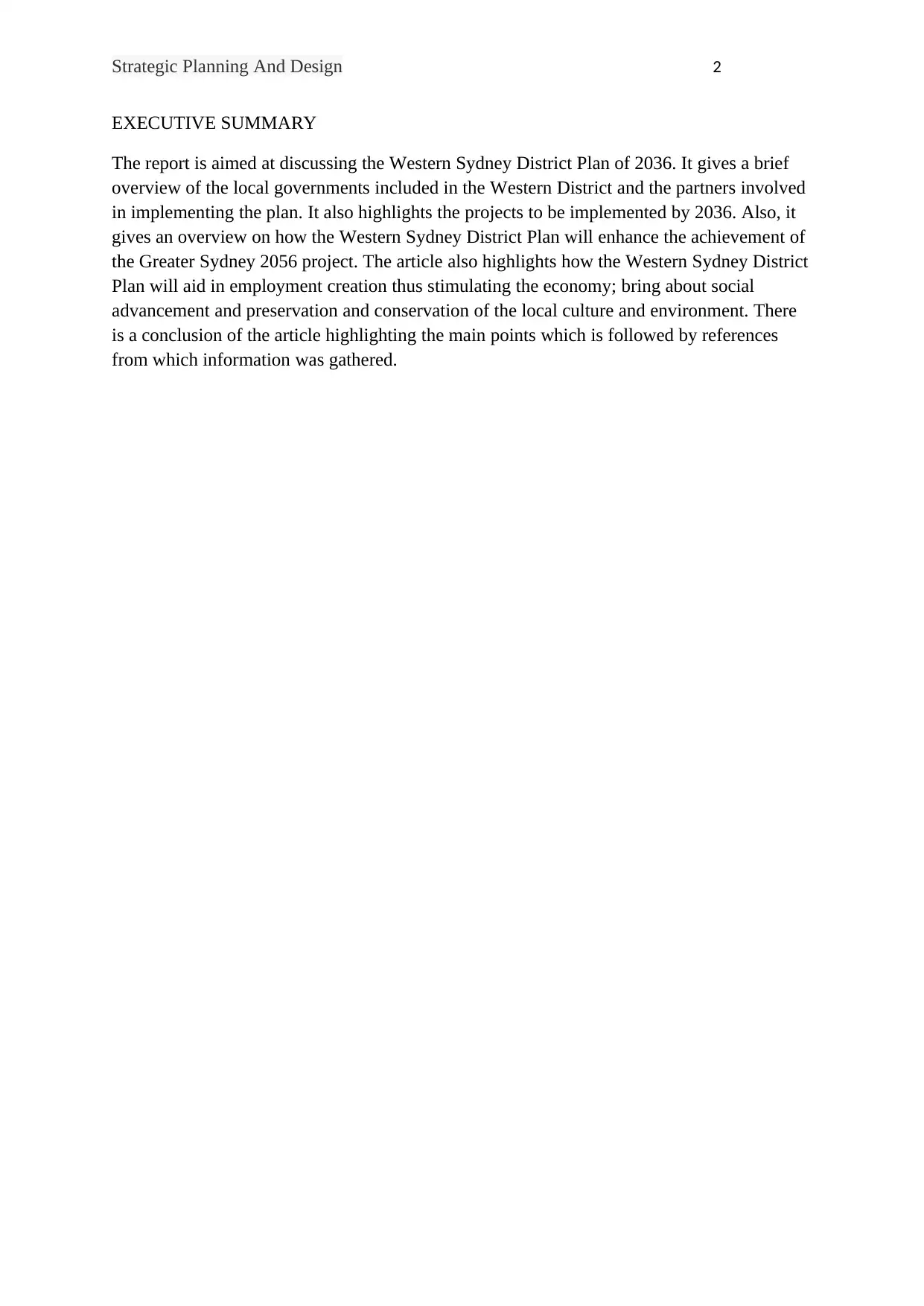
Strategic Planning And Design 2
EXECUTIVE SUMMARY
The report is aimed at discussing the Western Sydney District Plan of 2036. It gives a brief
overview of the local governments included in the Western District and the partners involved
in implementing the plan. It also highlights the projects to be implemented by 2036. Also, it
gives an overview on how the Western Sydney District Plan will enhance the achievement of
the Greater Sydney 2056 project. The article also highlights how the Western Sydney District
Plan will aid in employment creation thus stimulating the economy; bring about social
advancement and preservation and conservation of the local culture and environment. There
is a conclusion of the article highlighting the main points which is followed by references
from which information was gathered.
EXECUTIVE SUMMARY
The report is aimed at discussing the Western Sydney District Plan of 2036. It gives a brief
overview of the local governments included in the Western District and the partners involved
in implementing the plan. It also highlights the projects to be implemented by 2036. Also, it
gives an overview on how the Western Sydney District Plan will enhance the achievement of
the Greater Sydney 2056 project. The article also highlights how the Western Sydney District
Plan will aid in employment creation thus stimulating the economy; bring about social
advancement and preservation and conservation of the local culture and environment. There
is a conclusion of the article highlighting the main points which is followed by references
from which information was gathered.

Strategic Planning And Design 3
Table of Contents
INTRODUCTION.................................................................................................................................4
INVESTIGATION OF THE PRODUCTIVITY OBJECTIVE OF THE WESTERN CITY DISTRICT
PLAN....................................................................................................................................................5
Vision/aims........................................................................................................................................5
Objectives/ actions.............................................................................................................................5
Performance measurements...............................................................................................................6
How the Productivity Objective works in shaping the future of Greater Sydney?.........................6
How the Western Sydney Airport – Badgerys Creek Aeotropolis will shape the future of Greater
Sydney and the western city district and how will help in creating jobs and economic
opportunities?................................................................................................................................7
How the Economic Corridor will help in creating jobs and economic opportunities and how it
will collaborate to serve the Greater Sydney Region Plan (GSRP)?..............................................7
CONCLUSION.....................................................................................................................................9
REFERENCES....................................................................................................................................10
Table of Contents
INTRODUCTION.................................................................................................................................4
INVESTIGATION OF THE PRODUCTIVITY OBJECTIVE OF THE WESTERN CITY DISTRICT
PLAN....................................................................................................................................................5
Vision/aims........................................................................................................................................5
Objectives/ actions.............................................................................................................................5
Performance measurements...............................................................................................................6
How the Productivity Objective works in shaping the future of Greater Sydney?.........................6
How the Western Sydney Airport – Badgerys Creek Aeotropolis will shape the future of Greater
Sydney and the western city district and how will help in creating jobs and economic
opportunities?................................................................................................................................7
How the Economic Corridor will help in creating jobs and economic opportunities and how it
will collaborate to serve the Greater Sydney Region Plan (GSRP)?..............................................7
CONCLUSION.....................................................................................................................................9
REFERENCES....................................................................................................................................10
⊘ This is a preview!⊘
Do you want full access?
Subscribe today to unlock all pages.

Trusted by 1+ million students worldwide
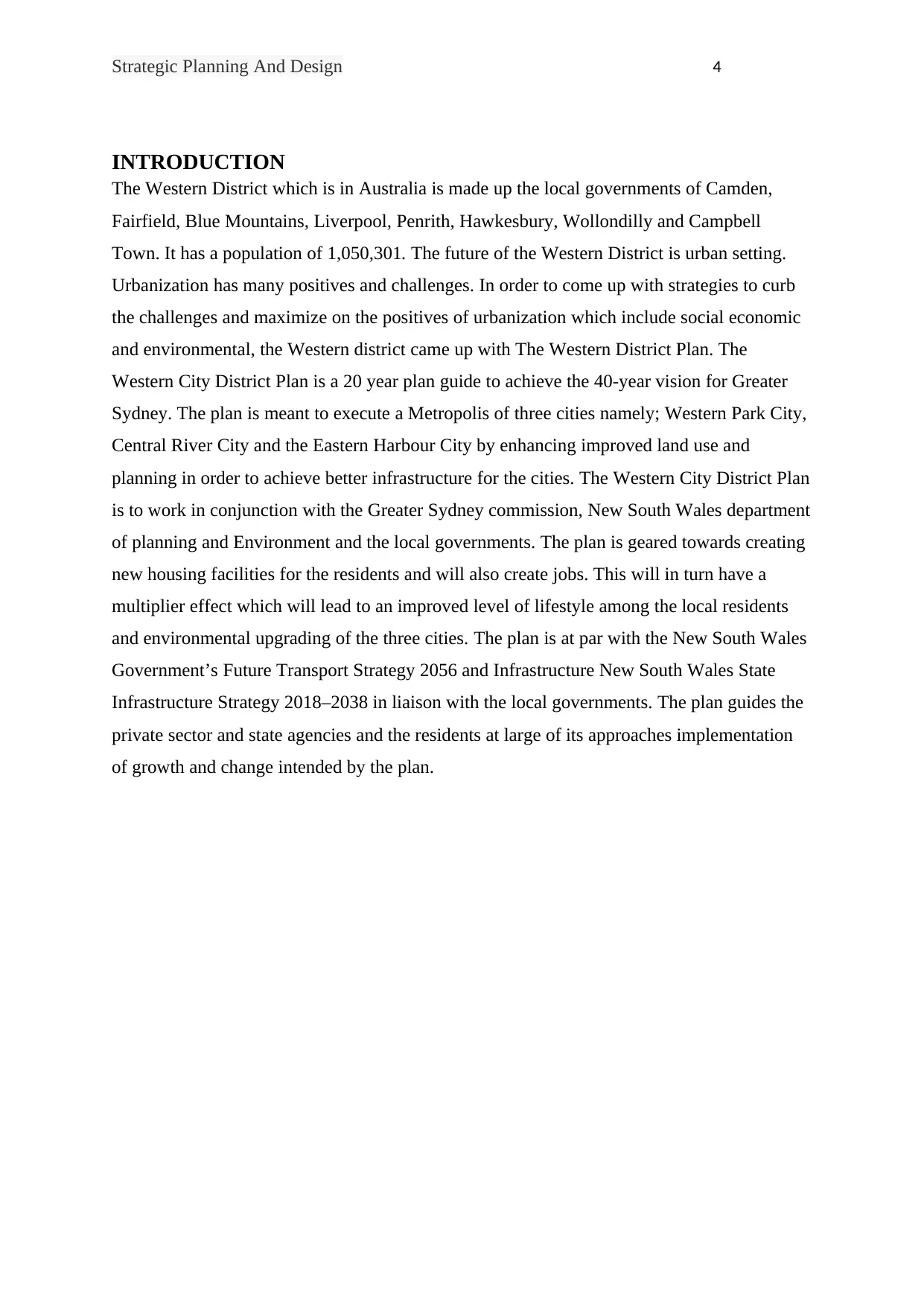
Strategic Planning And Design 4
INTRODUCTION
The Western District which is in Australia is made up the local governments of Camden,
Fairfield, Blue Mountains, Liverpool, Penrith, Hawkesbury, Wollondilly and Campbell
Town. It has a population of 1,050,301. The future of the Western District is urban setting.
Urbanization has many positives and challenges. In order to come up with strategies to curb
the challenges and maximize on the positives of urbanization which include social economic
and environmental, the Western district came up with The Western District Plan. The
Western City District Plan is a 20 year plan guide to achieve the 40-year vision for Greater
Sydney. The plan is meant to execute a Metropolis of three cities namely; Western Park City,
Central River City and the Eastern Harbour City by enhancing improved land use and
planning in order to achieve better infrastructure for the cities. The Western City District Plan
is to work in conjunction with the Greater Sydney commission, New South Wales department
of planning and Environment and the local governments. The plan is geared towards creating
new housing facilities for the residents and will also create jobs. This will in turn have a
multiplier effect which will lead to an improved level of lifestyle among the local residents
and environmental upgrading of the three cities. The plan is at par with the New South Wales
Government’s Future Transport Strategy 2056 and Infrastructure New South Wales State
Infrastructure Strategy 2018–2038 in liaison with the local governments. The plan guides the
private sector and state agencies and the residents at large of its approaches implementation
of growth and change intended by the plan.
INTRODUCTION
The Western District which is in Australia is made up the local governments of Camden,
Fairfield, Blue Mountains, Liverpool, Penrith, Hawkesbury, Wollondilly and Campbell
Town. It has a population of 1,050,301. The future of the Western District is urban setting.
Urbanization has many positives and challenges. In order to come up with strategies to curb
the challenges and maximize on the positives of urbanization which include social economic
and environmental, the Western district came up with The Western District Plan. The
Western City District Plan is a 20 year plan guide to achieve the 40-year vision for Greater
Sydney. The plan is meant to execute a Metropolis of three cities namely; Western Park City,
Central River City and the Eastern Harbour City by enhancing improved land use and
planning in order to achieve better infrastructure for the cities. The Western City District Plan
is to work in conjunction with the Greater Sydney commission, New South Wales department
of planning and Environment and the local governments. The plan is geared towards creating
new housing facilities for the residents and will also create jobs. This will in turn have a
multiplier effect which will lead to an improved level of lifestyle among the local residents
and environmental upgrading of the three cities. The plan is at par with the New South Wales
Government’s Future Transport Strategy 2056 and Infrastructure New South Wales State
Infrastructure Strategy 2018–2038 in liaison with the local governments. The plan guides the
private sector and state agencies and the residents at large of its approaches implementation
of growth and change intended by the plan.
Paraphrase This Document
Need a fresh take? Get an instant paraphrase of this document with our AI Paraphraser
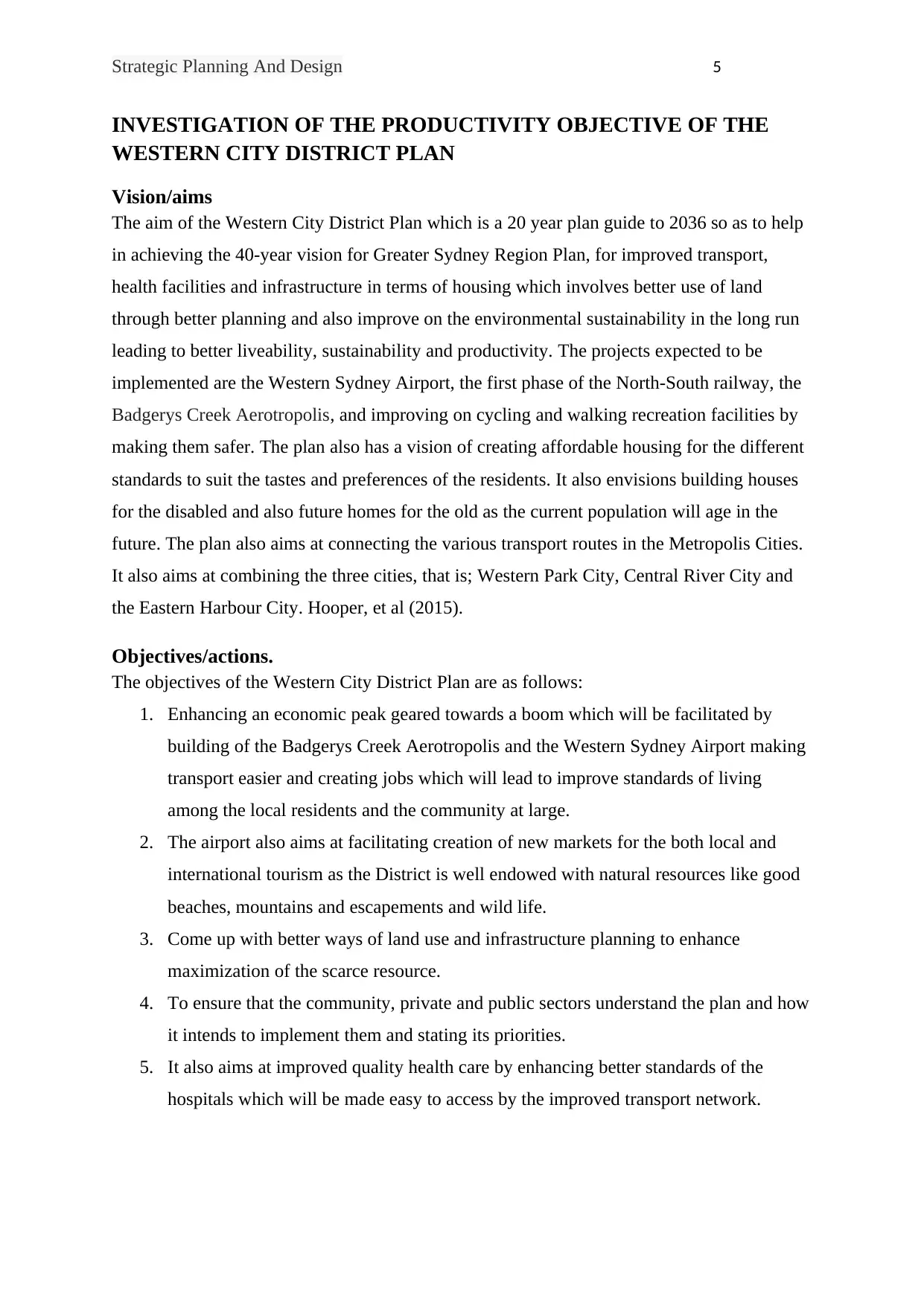
Strategic Planning And Design 5
INVESTIGATION OF THE PRODUCTIVITY OBJECTIVE OF THE
WESTERN CITY DISTRICT PLAN
Vision/aims
The aim of the Western City District Plan which is a 20 year plan guide to 2036 so as to help
in achieving the 40-year vision for Greater Sydney Region Plan, for improved transport,
health facilities and infrastructure in terms of housing which involves better use of land
through better planning and also improve on the environmental sustainability in the long run
leading to better liveability, sustainability and productivity. The projects expected to be
implemented are the Western Sydney Airport, the first phase of the North-South railway, the
Badgerys Creek Aerotropolis, and improving on cycling and walking recreation facilities by
making them safer. The plan also has a vision of creating affordable housing for the different
standards to suit the tastes and preferences of the residents. It also envisions building houses
for the disabled and also future homes for the old as the current population will age in the
future. The plan also aims at connecting the various transport routes in the Metropolis Cities.
It also aims at combining the three cities, that is; Western Park City, Central River City and
the Eastern Harbour City. Hooper, et al (2015).
Objectives/actions.
The objectives of the Western City District Plan are as follows:
1. Enhancing an economic peak geared towards a boom which will be facilitated by
building of the Badgerys Creek Aerotropolis and the Western Sydney Airport making
transport easier and creating jobs which will lead to improve standards of living
among the local residents and the community at large.
2. The airport also aims at facilitating creation of new markets for the both local and
international tourism as the District is well endowed with natural resources like good
beaches, mountains and escapements and wild life.
3. Come up with better ways of land use and infrastructure planning to enhance
maximization of the scarce resource.
4. To ensure that the community, private and public sectors understand the plan and how
it intends to implement them and stating its priorities.
5. It also aims at improved quality health care by enhancing better standards of the
hospitals which will be made easy to access by the improved transport network.
INVESTIGATION OF THE PRODUCTIVITY OBJECTIVE OF THE
WESTERN CITY DISTRICT PLAN
Vision/aims
The aim of the Western City District Plan which is a 20 year plan guide to 2036 so as to help
in achieving the 40-year vision for Greater Sydney Region Plan, for improved transport,
health facilities and infrastructure in terms of housing which involves better use of land
through better planning and also improve on the environmental sustainability in the long run
leading to better liveability, sustainability and productivity. The projects expected to be
implemented are the Western Sydney Airport, the first phase of the North-South railway, the
Badgerys Creek Aerotropolis, and improving on cycling and walking recreation facilities by
making them safer. The plan also has a vision of creating affordable housing for the different
standards to suit the tastes and preferences of the residents. It also envisions building houses
for the disabled and also future homes for the old as the current population will age in the
future. The plan also aims at connecting the various transport routes in the Metropolis Cities.
It also aims at combining the three cities, that is; Western Park City, Central River City and
the Eastern Harbour City. Hooper, et al (2015).
Objectives/actions.
The objectives of the Western City District Plan are as follows:
1. Enhancing an economic peak geared towards a boom which will be facilitated by
building of the Badgerys Creek Aerotropolis and the Western Sydney Airport making
transport easier and creating jobs which will lead to improve standards of living
among the local residents and the community at large.
2. The airport also aims at facilitating creation of new markets for the both local and
international tourism as the District is well endowed with natural resources like good
beaches, mountains and escapements and wild life.
3. Come up with better ways of land use and infrastructure planning to enhance
maximization of the scarce resource.
4. To ensure that the community, private and public sectors understand the plan and how
it intends to implement them and stating its priorities.
5. It also aims at improved quality health care by enhancing better standards of the
hospitals which will be made easy to access by the improved transport network.
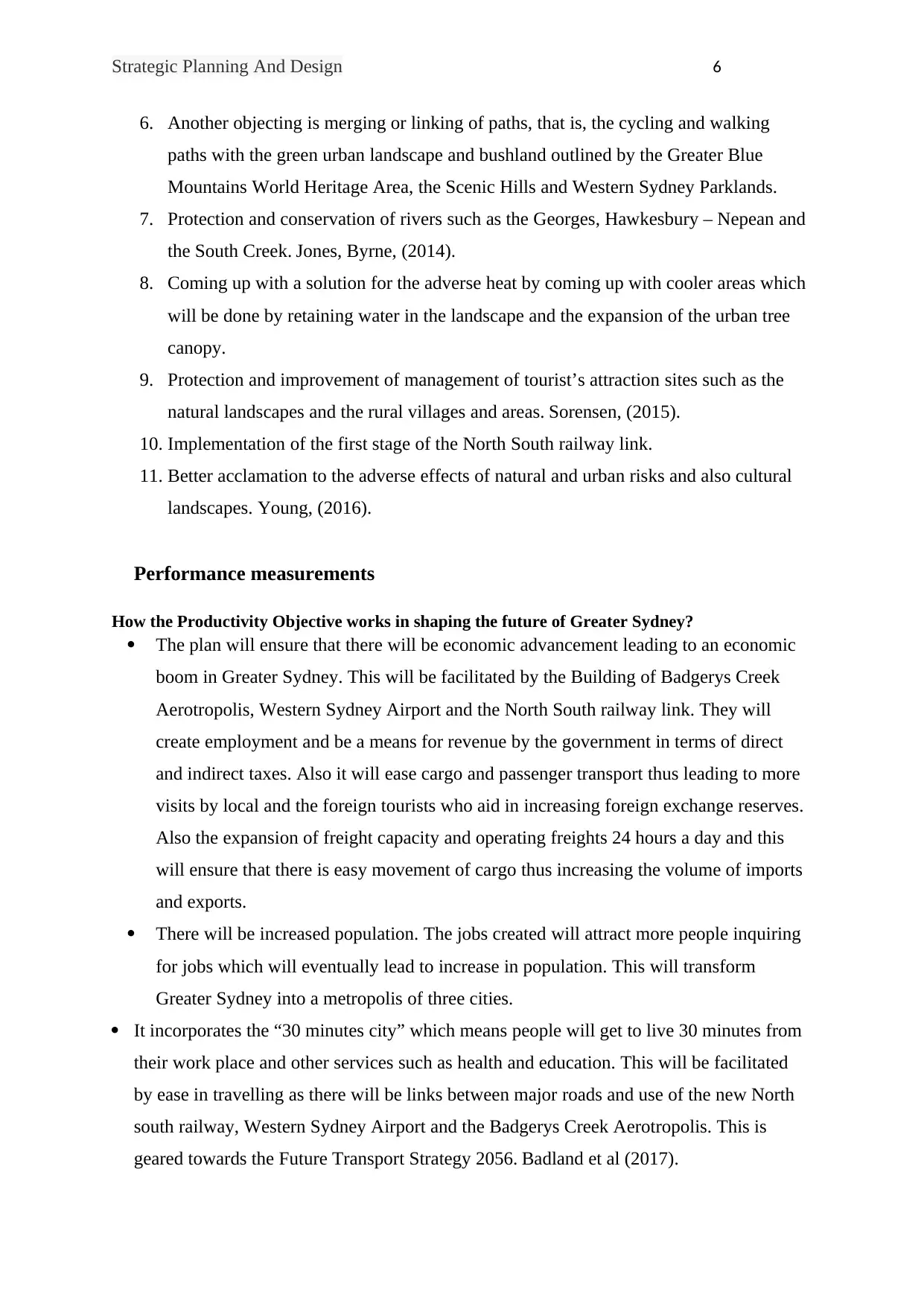
Strategic Planning And Design 6
6. Another objecting is merging or linking of paths, that is, the cycling and walking
paths with the green urban landscape and bushland outlined by the Greater Blue
Mountains World Heritage Area, the Scenic Hills and Western Sydney Parklands.
7. Protection and conservation of rivers such as the Georges, Hawkesbury – Nepean and
the South Creek. Jones, Byrne, (2014).
8. Coming up with a solution for the adverse heat by coming up with cooler areas which
will be done by retaining water in the landscape and the expansion of the urban tree
canopy.
9. Protection and improvement of management of tourist’s attraction sites such as the
natural landscapes and the rural villages and areas. Sorensen, (2015).
10. Implementation of the first stage of the North South railway link.
11. Better acclamation to the adverse effects of natural and urban risks and also cultural
landscapes. Young, (2016).
Performance measurements
How the Productivity Objective works in shaping the future of Greater Sydney?
The plan will ensure that there will be economic advancement leading to an economic
boom in Greater Sydney. This will be facilitated by the Building of Badgerys Creek
Aerotropolis, Western Sydney Airport and the North South railway link. They will
create employment and be a means for revenue by the government in terms of direct
and indirect taxes. Also it will ease cargo and passenger transport thus leading to more
visits by local and the foreign tourists who aid in increasing foreign exchange reserves.
Also the expansion of freight capacity and operating freights 24 hours a day and this
will ensure that there is easy movement of cargo thus increasing the volume of imports
and exports.
There will be increased population. The jobs created will attract more people inquiring
for jobs which will eventually lead to increase in population. This will transform
Greater Sydney into a metropolis of three cities.
It incorporates the “30 minutes city” which means people will get to live 30 minutes from
their work place and other services such as health and education. This will be facilitated
by ease in travelling as there will be links between major roads and use of the new North
south railway, Western Sydney Airport and the Badgerys Creek Aerotropolis. This is
geared towards the Future Transport Strategy 2056. Badland et al (2017).
6. Another objecting is merging or linking of paths, that is, the cycling and walking
paths with the green urban landscape and bushland outlined by the Greater Blue
Mountains World Heritage Area, the Scenic Hills and Western Sydney Parklands.
7. Protection and conservation of rivers such as the Georges, Hawkesbury – Nepean and
the South Creek. Jones, Byrne, (2014).
8. Coming up with a solution for the adverse heat by coming up with cooler areas which
will be done by retaining water in the landscape and the expansion of the urban tree
canopy.
9. Protection and improvement of management of tourist’s attraction sites such as the
natural landscapes and the rural villages and areas. Sorensen, (2015).
10. Implementation of the first stage of the North South railway link.
11. Better acclamation to the adverse effects of natural and urban risks and also cultural
landscapes. Young, (2016).
Performance measurements
How the Productivity Objective works in shaping the future of Greater Sydney?
The plan will ensure that there will be economic advancement leading to an economic
boom in Greater Sydney. This will be facilitated by the Building of Badgerys Creek
Aerotropolis, Western Sydney Airport and the North South railway link. They will
create employment and be a means for revenue by the government in terms of direct
and indirect taxes. Also it will ease cargo and passenger transport thus leading to more
visits by local and the foreign tourists who aid in increasing foreign exchange reserves.
Also the expansion of freight capacity and operating freights 24 hours a day and this
will ensure that there is easy movement of cargo thus increasing the volume of imports
and exports.
There will be increased population. The jobs created will attract more people inquiring
for jobs which will eventually lead to increase in population. This will transform
Greater Sydney into a metropolis of three cities.
It incorporates the “30 minutes city” which means people will get to live 30 minutes from
their work place and other services such as health and education. This will be facilitated
by ease in travelling as there will be links between major roads and use of the new North
south railway, Western Sydney Airport and the Badgerys Creek Aerotropolis. This is
geared towards the Future Transport Strategy 2056. Badland et al (2017).
⊘ This is a preview!⊘
Do you want full access?
Subscribe today to unlock all pages.

Trusted by 1+ million students worldwide
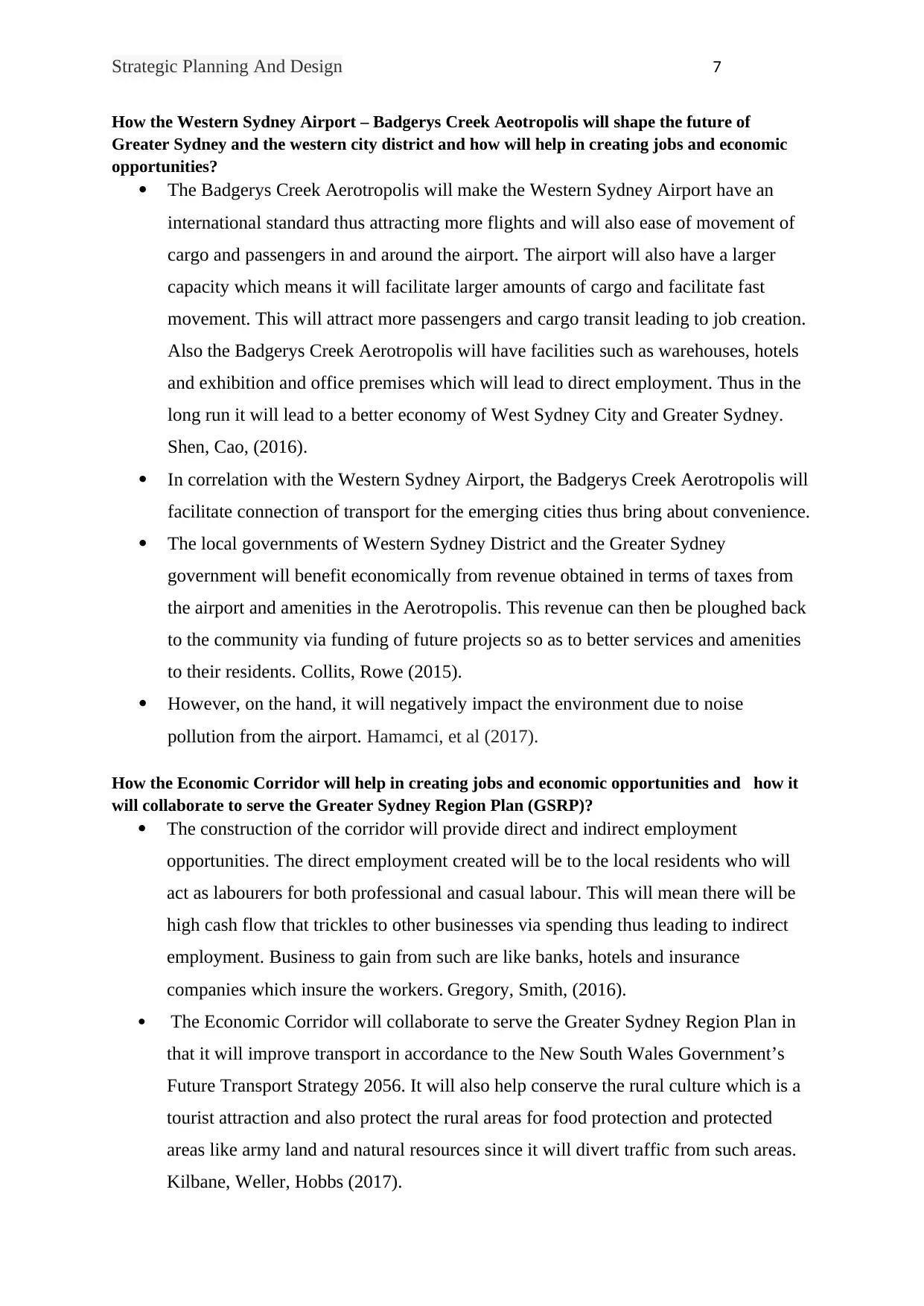
Strategic Planning And Design 7
How the Western Sydney Airport – Badgerys Creek Aeotropolis will shape the future of
Greater Sydney and the western city district and how will help in creating jobs and economic
opportunities?
The Badgerys Creek Aerotropolis will make the Western Sydney Airport have an
international standard thus attracting more flights and will also ease of movement of
cargo and passengers in and around the airport. The airport will also have a larger
capacity which means it will facilitate larger amounts of cargo and facilitate fast
movement. This will attract more passengers and cargo transit leading to job creation.
Also the Badgerys Creek Aerotropolis will have facilities such as warehouses, hotels
and exhibition and office premises which will lead to direct employment. Thus in the
long run it will lead to a better economy of West Sydney City and Greater Sydney.
Shen, Cao, (2016).
In correlation with the Western Sydney Airport, the Badgerys Creek Aerotropolis will
facilitate connection of transport for the emerging cities thus bring about convenience.
The local governments of Western Sydney District and the Greater Sydney
government will benefit economically from revenue obtained in terms of taxes from
the airport and amenities in the Aerotropolis. This revenue can then be ploughed back
to the community via funding of future projects so as to better services and amenities
to their residents. Collits, Rowe (2015).
However, on the hand, it will negatively impact the environment due to noise
pollution from the airport. Hamamci, et al (2017).
How the Economic Corridor will help in creating jobs and economic opportunities and how it
will collaborate to serve the Greater Sydney Region Plan (GSRP)?
The construction of the corridor will provide direct and indirect employment
opportunities. The direct employment created will be to the local residents who will
act as labourers for both professional and casual labour. This will mean there will be
high cash flow that trickles to other businesses via spending thus leading to indirect
employment. Business to gain from such are like banks, hotels and insurance
companies which insure the workers. Gregory, Smith, (2016).
The Economic Corridor will collaborate to serve the Greater Sydney Region Plan in
that it will improve transport in accordance to the New South Wales Government’s
Future Transport Strategy 2056. It will also help conserve the rural culture which is a
tourist attraction and also protect the rural areas for food protection and protected
areas like army land and natural resources since it will divert traffic from such areas.
Kilbane, Weller, Hobbs (2017).
How the Western Sydney Airport – Badgerys Creek Aeotropolis will shape the future of
Greater Sydney and the western city district and how will help in creating jobs and economic
opportunities?
The Badgerys Creek Aerotropolis will make the Western Sydney Airport have an
international standard thus attracting more flights and will also ease of movement of
cargo and passengers in and around the airport. The airport will also have a larger
capacity which means it will facilitate larger amounts of cargo and facilitate fast
movement. This will attract more passengers and cargo transit leading to job creation.
Also the Badgerys Creek Aerotropolis will have facilities such as warehouses, hotels
and exhibition and office premises which will lead to direct employment. Thus in the
long run it will lead to a better economy of West Sydney City and Greater Sydney.
Shen, Cao, (2016).
In correlation with the Western Sydney Airport, the Badgerys Creek Aerotropolis will
facilitate connection of transport for the emerging cities thus bring about convenience.
The local governments of Western Sydney District and the Greater Sydney
government will benefit economically from revenue obtained in terms of taxes from
the airport and amenities in the Aerotropolis. This revenue can then be ploughed back
to the community via funding of future projects so as to better services and amenities
to their residents. Collits, Rowe (2015).
However, on the hand, it will negatively impact the environment due to noise
pollution from the airport. Hamamci, et al (2017).
How the Economic Corridor will help in creating jobs and economic opportunities and how it
will collaborate to serve the Greater Sydney Region Plan (GSRP)?
The construction of the corridor will provide direct and indirect employment
opportunities. The direct employment created will be to the local residents who will
act as labourers for both professional and casual labour. This will mean there will be
high cash flow that trickles to other businesses via spending thus leading to indirect
employment. Business to gain from such are like banks, hotels and insurance
companies which insure the workers. Gregory, Smith, (2016).
The Economic Corridor will collaborate to serve the Greater Sydney Region Plan in
that it will improve transport in accordance to the New South Wales Government’s
Future Transport Strategy 2056. It will also help conserve the rural culture which is a
tourist attraction and also protect the rural areas for food protection and protected
areas like army land and natural resources since it will divert traffic from such areas.
Kilbane, Weller, Hobbs (2017).
Paraphrase This Document
Need a fresh take? Get an instant paraphrase of this document with our AI Paraphraser
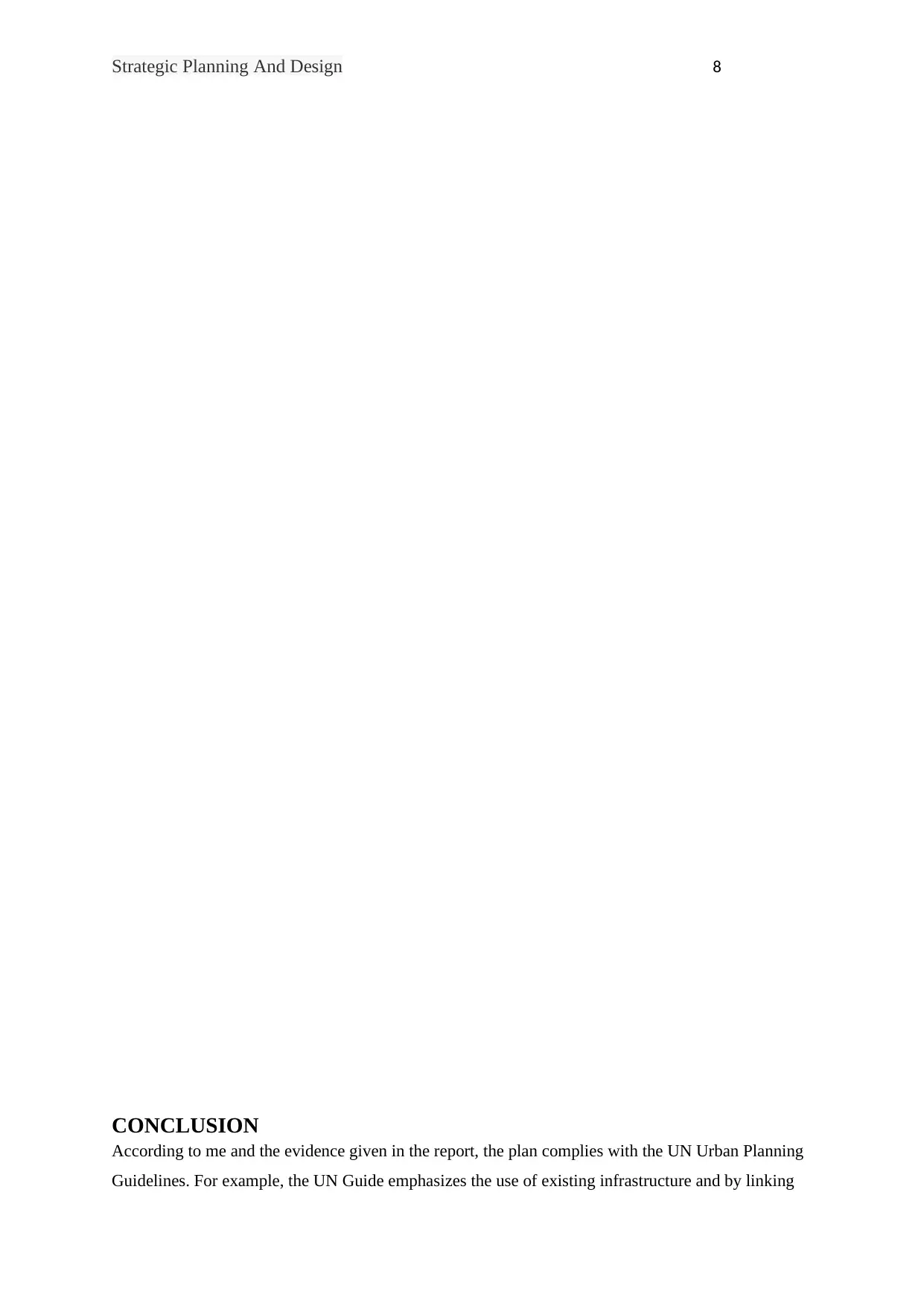
Strategic Planning And Design 8
CONCLUSION
According to me and the evidence given in the report, the plan complies with the UN Urban Planning
Guidelines. For example, the UN Guide emphasizes the use of existing infrastructure and by linking
CONCLUSION
According to me and the evidence given in the report, the plan complies with the UN Urban Planning
Guidelines. For example, the UN Guide emphasizes the use of existing infrastructure and by linking

Strategic Planning And Design 9
roads and the South-North railway makes sure that resources are linked and hence using the existing
infrastructure. It also emphasizes protection of the environment and on conservation of rivers and the
WSDP has this as one of its agenda. Developing cycling and walking paths are also key in reducing
the environmental hazards caused by automotives like air and noise pollution. Also both the WSDP
and Greater Sydney plan will create jobs as the guideline emphasizes in promotion on economies of
scale. Despite protecting the rural area due to their role in food production, it also seeks to connect the
rural areas with the urban areas.
roads and the South-North railway makes sure that resources are linked and hence using the existing
infrastructure. It also emphasizes protection of the environment and on conservation of rivers and the
WSDP has this as one of its agenda. Developing cycling and walking paths are also key in reducing
the environmental hazards caused by automotives like air and noise pollution. Also both the WSDP
and Greater Sydney plan will create jobs as the guideline emphasizes in promotion on economies of
scale. Despite protecting the rural area due to their role in food production, it also seeks to connect the
rural areas with the urban areas.
⊘ This is a preview!⊘
Do you want full access?
Subscribe today to unlock all pages.

Trusted by 1+ million students worldwide
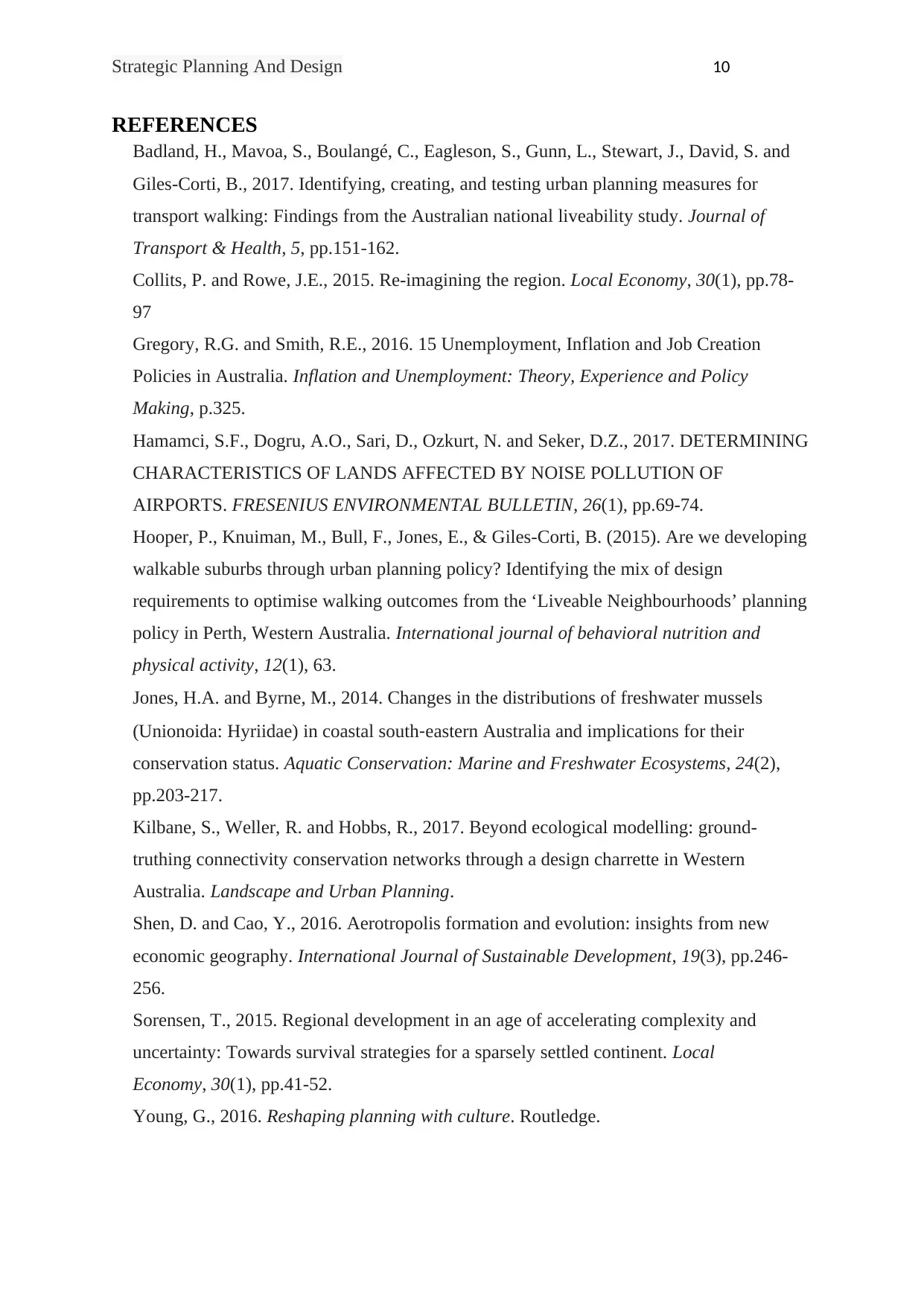
Strategic Planning And Design 10
REFERENCES
Badland, H., Mavoa, S., Boulangé, C., Eagleson, S., Gunn, L., Stewart, J., David, S. and
Giles-Corti, B., 2017. Identifying, creating, and testing urban planning measures for
transport walking: Findings from the Australian national liveability study. Journal of
Transport & Health, 5, pp.151-162.
Collits, P. and Rowe, J.E., 2015. Re-imagining the region. Local Economy, 30(1), pp.78-
97
Gregory, R.G. and Smith, R.E., 2016. 15 Unemployment, Inflation and Job Creation
Policies in Australia. Inflation and Unemployment: Theory, Experience and Policy
Making, p.325.
Hamamci, S.F., Dogru, A.O., Sari, D., Ozkurt, N. and Seker, D.Z., 2017. DETERMINING
CHARACTERISTICS OF LANDS AFFECTED BY NOISE POLLUTION OF
AIRPORTS. FRESENIUS ENVIRONMENTAL BULLETIN, 26(1), pp.69-74.
Hooper, P., Knuiman, M., Bull, F., Jones, E., & Giles-Corti, B. (2015). Are we developing
walkable suburbs through urban planning policy? Identifying the mix of design
requirements to optimise walking outcomes from the ‘Liveable Neighbourhoods’ planning
policy in Perth, Western Australia. International journal of behavioral nutrition and
physical activity, 12(1), 63.
Jones, H.A. and Byrne, M., 2014. Changes in the distributions of freshwater mussels
(Unionoida: Hyriidae) in coastal south‐eastern Australia and implications for their
conservation status. Aquatic Conservation: Marine and Freshwater Ecosystems, 24(2),
pp.203-217.
Kilbane, S., Weller, R. and Hobbs, R., 2017. Beyond ecological modelling: ground-
truthing connectivity conservation networks through a design charrette in Western
Australia. Landscape and Urban Planning.
Shen, D. and Cao, Y., 2016. Aerotropolis formation and evolution: insights from new
economic geography. International Journal of Sustainable Development, 19(3), pp.246-
256.
Sorensen, T., 2015. Regional development in an age of accelerating complexity and
uncertainty: Towards survival strategies for a sparsely settled continent. Local
Economy, 30(1), pp.41-52.
Young, G., 2016. Reshaping planning with culture. Routledge.
REFERENCES
Badland, H., Mavoa, S., Boulangé, C., Eagleson, S., Gunn, L., Stewart, J., David, S. and
Giles-Corti, B., 2017. Identifying, creating, and testing urban planning measures for
transport walking: Findings from the Australian national liveability study. Journal of
Transport & Health, 5, pp.151-162.
Collits, P. and Rowe, J.E., 2015. Re-imagining the region. Local Economy, 30(1), pp.78-
97
Gregory, R.G. and Smith, R.E., 2016. 15 Unemployment, Inflation and Job Creation
Policies in Australia. Inflation and Unemployment: Theory, Experience and Policy
Making, p.325.
Hamamci, S.F., Dogru, A.O., Sari, D., Ozkurt, N. and Seker, D.Z., 2017. DETERMINING
CHARACTERISTICS OF LANDS AFFECTED BY NOISE POLLUTION OF
AIRPORTS. FRESENIUS ENVIRONMENTAL BULLETIN, 26(1), pp.69-74.
Hooper, P., Knuiman, M., Bull, F., Jones, E., & Giles-Corti, B. (2015). Are we developing
walkable suburbs through urban planning policy? Identifying the mix of design
requirements to optimise walking outcomes from the ‘Liveable Neighbourhoods’ planning
policy in Perth, Western Australia. International journal of behavioral nutrition and
physical activity, 12(1), 63.
Jones, H.A. and Byrne, M., 2014. Changes in the distributions of freshwater mussels
(Unionoida: Hyriidae) in coastal south‐eastern Australia and implications for their
conservation status. Aquatic Conservation: Marine and Freshwater Ecosystems, 24(2),
pp.203-217.
Kilbane, S., Weller, R. and Hobbs, R., 2017. Beyond ecological modelling: ground-
truthing connectivity conservation networks through a design charrette in Western
Australia. Landscape and Urban Planning.
Shen, D. and Cao, Y., 2016. Aerotropolis formation and evolution: insights from new
economic geography. International Journal of Sustainable Development, 19(3), pp.246-
256.
Sorensen, T., 2015. Regional development in an age of accelerating complexity and
uncertainty: Towards survival strategies for a sparsely settled continent. Local
Economy, 30(1), pp.41-52.
Young, G., 2016. Reshaping planning with culture. Routledge.
1 out of 10
Related Documents
Your All-in-One AI-Powered Toolkit for Academic Success.
+13062052269
info@desklib.com
Available 24*7 on WhatsApp / Email
![[object Object]](/_next/static/media/star-bottom.7253800d.svg)
Unlock your academic potential
Copyright © 2020–2025 A2Z Services. All Rights Reserved. Developed and managed by ZUCOL.





